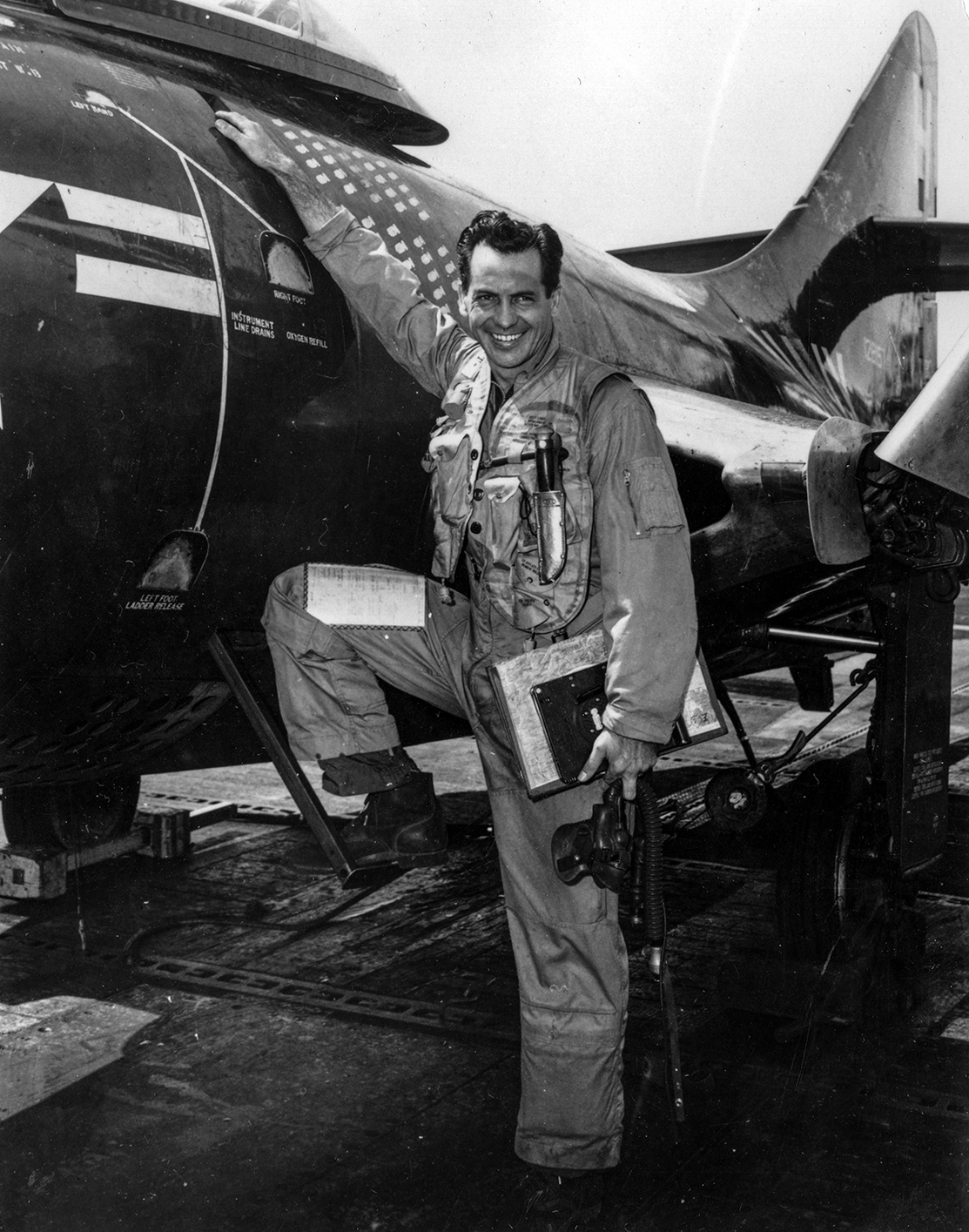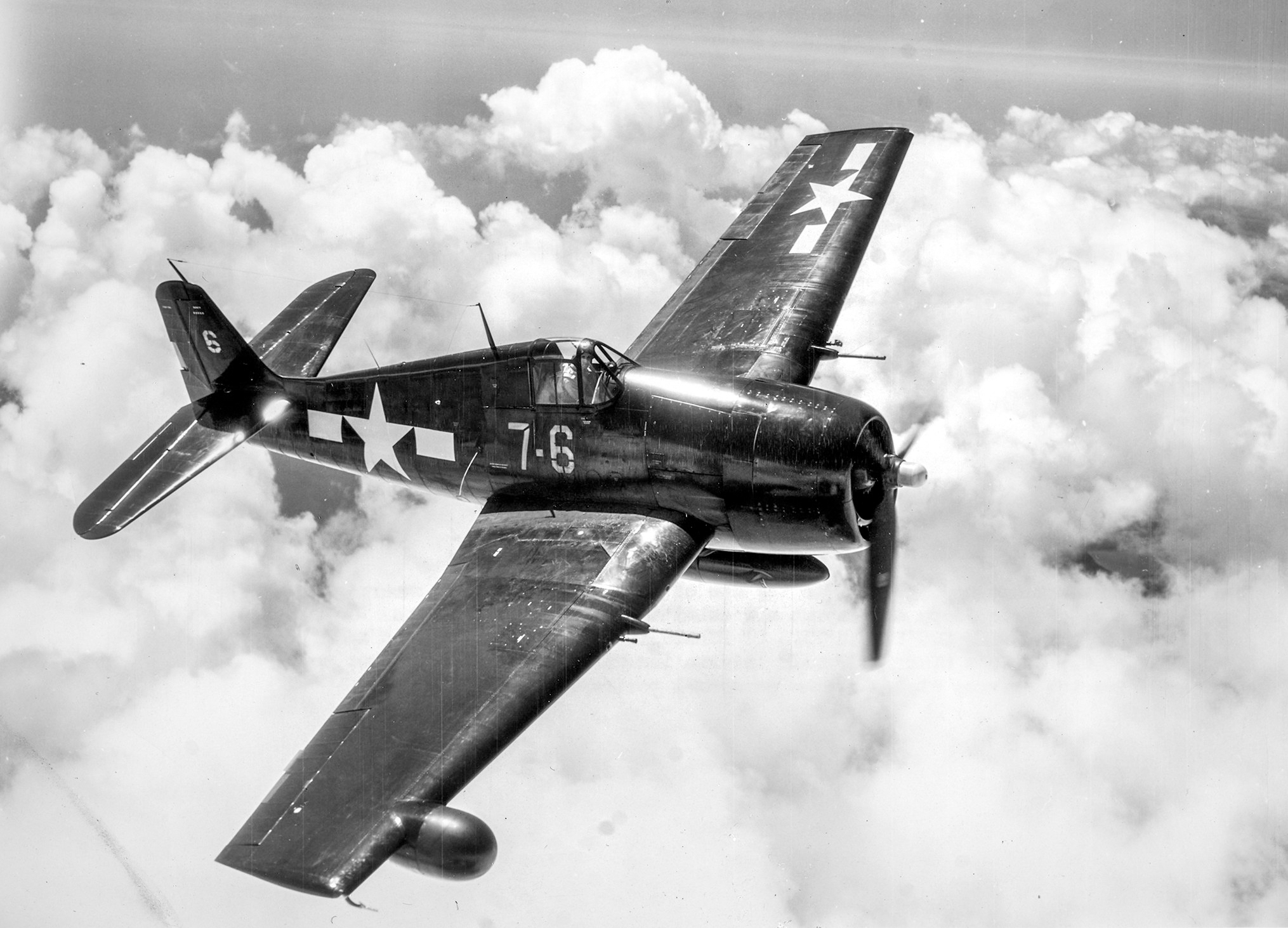
Miller, Gerald E., Vice Adm., USN (Ret.)
(1919–2014)
In order to get into naval aviation, Admiral Miller took a long route. He enlisted in the Navy in 1936 and served in the fleet for two years before getting an appointment to the Naval Academy, from which he was graduated in late 1941. He then spent two years of wartime duty in the light cruiser USS Richmond (CL-9) before he could go to flight training. He didn't get an opportunity for wartime air combat. After the war, he went to postgraduate school at Stanford University and continued his flying career. Throughout his aviation experiences, he placed particular emphasis on night-time flight operations.
During the Korean War, he served on the staff of Rear Admiral E. C. Ewen, Commander Task Force 77, and then commanded a fighter squadron. During a mid-1950s tour in the Bureau of Naval Personnel, Miller was instrumental in the installation of computers and reorganizing the distribution of enlisted personnel. After commanding a carrier air group, he was sent to Omaha, Nebraska, to work with the Air Force in joint strategic target planning. In the early 1960s, he commanded the ammunition ship USS Wrangell (AE-12) and the attack aircraft carrier Franklin D. Roosevelt (CVA-42). In discussing the latter, he stresses Mediterranean operations and the role of the commanding officer as leader.
The concluding volume picks up his story when he was serving as aide to the Vice Chief of Naval Operations, Admiral Horacio Rivero, during which time he indoctrinated the admiral in naval aviation. In his next duty, as Director, Aviation Plans Division in OpNav, Miller played a role in the knockdown of the controversial F-111B program. He also pushed for the purchase of RA-5 reconnaissance aircraft, a decision he subsequently came to regret. He concedes he was given little role in the Vietnam War but did participate in a satisfying electronic silence naval exercise off Korea.
Following duty as Assistant DCNO (Air), he became Commander Second Fleet and observed what he felt were the negative effects of Z-grams. Miller considers his Second Fleet duty to have been perfect preparation for his subsequent tour as Commander Sixth Fleet. Facets covered from this service were dealings with the Soviet ships in the Mediterranean, racial tensions, and the deterioration of discipline and appearance among the fleet's sailors. Miller sought to reverse the trend resulting from Z-grams and says he considered the possibility Admiral Zumwalt would fire him for his efforts. In his final tour, Admiral Miller was Deputy Director of the Joint Strategic Target Planning Staff in Omaha, and he made it a project to familiarize U.S. civilian and military leaders with operational plans for nuclear war. Throughout his narrative, Miller's strong leadership style is evident, and he offers opinions on the application and failure of leadership skills.
“A Lot of People Are Not Going to Believe This in Future Years”
In this audio clip excerpted from his 1976 oral history interviews, Vice Admiral Miller describes the dangers and limitations faced by those, like himself, who were pioneering the use of jets in night fighter training during the Korean War.
(Note: Due to edits, corrections, and/or amendments to the original transcription draft, there are some inconsistencies between the recording and the text.)
Vice Admiral Miller: I spent about six or seven months at Alameda and then I was given the opportunity to get command of a jet fighter squadron and go to Korea.
John T. Mason, Jr.: Well, that was a necessary step to go to Alameda in order to get your command in Korea. It was not a demotion.
Vice Admiral Miller: No, I had to do that. And it worked out very well. For preparation for the squadron, Ewen let me go to the night fighter training program. It was in Hawaii by that time.
John T. Mason, Jr.: Tell me about that program.
Vice Admiral Miller: Well, it was interesting. I don't know how many people may have discussed it in oral history. By early 1952 we did not have jets in the night fighter program. We were still flying propeller airplanes, F6Fs at that time. They had a small radar, with a capability to detect a target at little more than a mile. You relied on surface air control radars and air control procedures to get you within that one mile of the target. The training program in Hawaii, designed to teach you how to get to that one mile position and then close for a kill, ran about one hundred and forty flying hours and usually took three months to finish.
I had asked to get an accelerated program because I was going to be the commanding officer of a squadron. Not many squadron commanders took the course. I worked this out, and thought it would be a good background. Even when I was going into a jet squadron, we were not doing much night or weather work with jets. We still hadn't figured that out. There were some doing night and weather work, but not many.
I took this course. The equipment we used was limited in what it could do. Once you were vectored up behind the target airplane, the radar would normally pick up the target at about one and one-half miles. You had to come in from the stern. The target aircraft was configured so that there was absolutely nothing you could see. We had flame dampeners on the manifold exhausts so that you didn't even get the flame from the exhaust. All lights were off on the target aircraft. You were looking for a black shadow against a black sky. The airplanes were all painted either dark blue or black. And they always had us over the water. Anybody who has ever been out over the water at night knows that if you're not looking towards the shore, it's like being in a big black cave. You can get disoriented very easily.
So, you're out in this black cave, looking for this black shadow, and all you have to assist you is a little radar that can reach up to one and one-half miles. The trainer for what to do after target detection is interesting. And I'm glad to get this in an oral history program, because a lot of people are not going to believe this in future years.
We had a synthetic trainer, a simulator, which was an F6F cockpit, mounted in a room that was painted black. The walls were black, the ceiling was black, everything was black – a real cave, just like it was going to be out at sea.
In those days, we used to wear red goggles to get our eyes adapted to the night. We had great night vision courses on how to see at night with your eyes. In the room with the cockpit was a projector that would project moving aircraft on a screen in front of the cockpit. They had rigged it so what they were showing you was a black shadow on a black wall in an unlighted room. You're sitting in the cockpit then, going through all the procedures, operating your equipment. You're finally in the position where you're one and one-half miles from the target aircraft. The radar's got it; you can see it on the radar. The radar would tell you whether the plane was up or down and right or left, but it couldn't give you the precise location. So, when you got in close enough for the actual firing of the guns, you had to see the aircraft visually. You could not use the radar then. It wasn't that sensitive. So now you had the problem of spotting this black shadow visually. Well, that's what the trainer was about. You were looking for that black shadow on that black wall, and in order to do it, you couldn't have any kind of a light, even the brilliance of the radar scope was too much.
So, the procedure was to come in, pick up the target on the radar, turn down the brilliance of the scope as much as you could, all lights off in the cockpit. When you got to where you should be able to pick up the target visually, you put your hand over the radar scope. With your hand over the scope and the throttle set, you would fly the airplane with the stick in the other hand. Then you would start searching for the black shadow.
Anybody will tell you in a night vision course that you see differently at night than in the daytime. I forget whether it's the cones you see with or the rods, but it's the opposite of what you see with in the daytime. You can never see a shadow at night if you look at it directly. So, you look to the left if you want to see to the right, or you look up if you really want to see down. So, you've got to train your eyes to look in different directions until you actually pick up the target.
John T. Mason, Jr.: What about the accuracy of it when you're not looking directly at it?
Vice Admiral Miller: Well, it will be all right if you can see it at all. It will be right where you see it, but in order to pick it up, you have to use a different seeing technique. And this was a well-known, accepted procedure for night fighter pilots. But there were not many night fighter pilots around. We didn't have many that went through these courses.
John T. Mason, Jr.: Not many could qualify anyhow.
Vice Admiral Miller: Well, night flying in those days eliminated a lot of people. A lot of men would not go into it. I've seen any number who would go through the training program. Then when they got to that night catapult shot off the carrier, some would quit. They might do the first, but not the second. It separated the men from the boys. There's no question about it. Back to the black shadow: The actual attack of the target was the fascinating part. In the trainer, you were looking for this black shadow on a black wall in a black room with all the lights out. Once you had practiced in the trainer, you could go out and do it in the air at night.
It was a feasible, valid system. Of course, compared to today’s long-range radar systems, air-to-air missiles, and so forth, there's no comparison, or need for such a technique. But that's what we were doing in 1952.
About Volume I
Based on four interviews conducted by John T. Mason Jr., from January through April 1976, the volume contains 417 pages of interview transcript plus an index. The transcript is copyright 1983 by the U.S. Naval Institute; the interviewee placed no restrictions on its use.
Volume II
Based on five interviews conducted by John T. Mason, Jr., from May 1976 through October 1976. The volume contains 375 pages of interview transcript plus an index. The transcript is copyright 1984 by the U.S. Naval Institute; the interviewee has placed no restrictions on its use.




